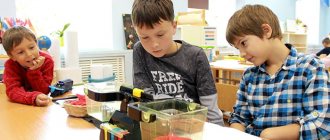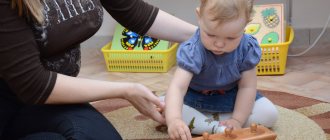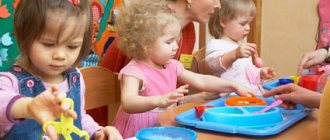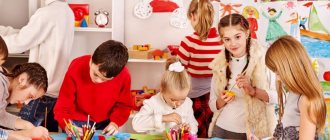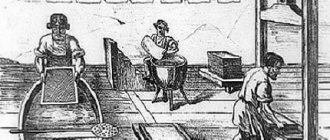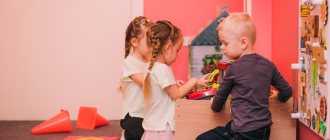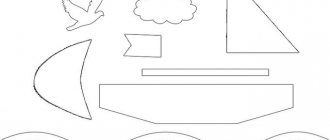Kindergartens and child development centers operating according to the Montessori system attract parents by the way they communicate with children, and last but not least, by the Montessori materials. It's truly hard to put down these educational games and sets! But their meaning is not only in beauty, but also in the benefits that they bring to the development of the child. We tell you how to conduct games using the Montessori method at home.
The entire Montessori classroom is dedicated to the development of sensory experiences. First of all, the child is asked to find pairs of objects that differ in only one characteristic, for example, height, length or thickness. In other exercises, he must find pairs of identical objects by weight, smell, taste, temperature or sound. Later, the child is asked to organize a group of objects in order based on one feature: for example, length, height, shade of color, shape, etc.
Children find these games and riddles interesting because they are challenging enough to be reasonably stimulating. They also learn the names of objects, from geometric shapes to plants and animals.
Today you will find 6 games to determine the color, shape and size of objects, as well as 4 activities to develop tactile sensitivity.
The activities we offer here are simpler than those practiced in Montessori schools, but are based on the same principles. You can make many items for them yourself, or perhaps they are already among your baby’s toys.
Sorting objects (2–5 years)
Sorting objects by shape, color or other physical characteristics is a great activity that encourages children to look closely at objects and make logical choices. You need several sets of items that differ in shape, color and size. Be careful with small objects as small children may swallow them or put them in their nose or ears.
A good option is button sorting. Buy or find at home several sets of four or more identical buttons. Mix them in a large bowl, then show your child how to pick one button, put it in a smaller bowl, and pick out all the same buttons from the larger bowl.
The main directions of child development in the Montessori system
Montessori games are aimed at the widespread use of all components of children's life.
The most important of them:
- Practice. Knowledge, experience, skills and abilities are acquired only through persistent practical training.
- Sensory perception. The world around us is known through the senses. They need to be developed.
- Mental exercises. Mathematics is the fundamental basis for all other sciences.
- Communication, language, verbal contacts. Socialization begins with them.
- Space. Children's abilities should “work” towards acquiring future professions.
Note. The last point of the program includes classes in applied sciences such as physics, chemistry, and biology. Games are also widely used to develop skills in drawing, music and languages. Parents can make their own manuals.
Combining multi-colored signs (3–5 years)
Montessori schools use ready-made sets of multi-colored wooden tablets, with the help of which children learn to distinguish primary colors, tones and shades, and also learn their names.
You can make the signs yourself. The signs can be used to create three separate sets of colors. The elements in the set must be the same size and differ only in color.
For kids, you can start with a set containing 6 signs in three colors: two each yellow, red and blue. Ask your child to match the paired signs and learn with him the names of the 3 primary colors.
When the child has mastered this task, prepare a set of signs of 11 pairs of primary colors and tones: yellow, red, blue, green, orange, purple, pink, brown, gray, black and white. Offer to find paired signs and name the colors.
To make it more challenging, create a third set of signs consisting of 7 shades of each of the 9 colors (yellow, red, blue, green, orange, purple, pink, brown, grey). Invite your child to arrange them in order from lightest to darkest. Once all the signs are neatly arranged on the tray, you will have a beautiful display of different colors.
There are also many games with such signs. For example, ask your child to find a sign of the color that is closest to the color of an object in the room. Another option: show your child a plate from the third set of colors and ask him, from memory, to find a plate with a color that is one tone lighter or darker than the one you showed.
The third option is to teach how to create lighter or darker shades by adding white or black paint to the base color. By starting with a base color and adding white paint little by little, a child can create a set of dark to light shades, similar to a set of wooden signs.
Sensory development in children
What are games used using the Montessori method? Almost any stationery material will do - paper, cardboard, paints, pencils, plasticine, etc.
Game for developing fine motor skills “Torn Applique”
The goal is to develop motor skills of the fingers of the upper limbs, coordination, and creative thinking.
Material – “decoration”, paper of different colors, magazines.
Game stages:
- Coloring pictures using scraps of paper - an introduction to the process.
- Practical application (tearing off) a piece of color and gluing it to drawings. The mentor shows how to do this.
- Independent creative work of the child. Upon completion - encouragement.
The final stage of the lesson is cleaning up materials and tools. Wiping the table.
Other options:
- Using crumpled paper balls. The material should be crumpled and made into balls for gluing. The task for the child is to make a three-dimensional image of a sheep.
- Using paper strips. They need to be rolled into a snail and then glued.
Note. Paper ornaments look beautiful. These types of activities help children maximize their creative potential.
Awareness game “The Cheerful Gardener”
Didactic games using the Montessori method develop motor skills, visual memory and attention.
The materials used are apples, pears or oranges of the same variety.
Story line:
- The child sees ten apples of the same variety laid out on the table. They are similar to each other, but have minor differences.
- Using the example of one apple, the mentor demonstrates specific differences - speck, color, shape, etc.
- The kid does the same with another apple - he voices specific differences.
- The teacher mixes all the apples and invites the child to find among them the one he verbally described.
At the end of the lesson - clearing away trash and supplies. The child must wipe the table and check that all things are in their place. To enhance the effect, all family members can participate in the game.
Advanced game:
- Use several dozen fruits.
- Play with smaller samples - nuts, plums, gooseberries.
The game can be used individually or for a small group of children.
Family game “Bouquet for Mom”
This activity develops finger motor skills, sensory abilities, memory and attention.
Flowers from the garden or wildflowers are used. A vase and water are also needed for the lesson.
How to play:
- Place the flowers on a flat surface.
- Pour water into the vase to a certain level.
- Show the children how to trim the lower leaves and pieces of stems, and align all the flowers to length.
- Distribute the flowers one by one.
- Demonstrate how flowers are given with wishes of goodness and happiness.
- Give your bouquet to the child, saying good wishes to him.
- He needs to repeat the whole ritual of giving after you.
Interact with kids so that they learn to notice their mistakes themselves and correct them. After the lesson - putting things in order and arranging bouquets in the rooms of the house.
A game that develops sensory skills – “Wonderful Bag”
The goal is to develop fine motor skills of the fingers, sensory skills, tactile memory, and attention coordination.
For the lesson, prepare a thick bag, various small objects, toys, stationery, etc.
How to play:
- Place a variety of items made of wood, plastic and glass - figurines, bottles, pebbles, toys - into a fabric bag.
- The child must find one of the objects with his hand, touch it and tell him what it is, what it looks like, what material it is made of.
- The correctness or otherwise of the judgment is checked after the object is removed from the bag.
The game is designed for the whole family to participate in turns. Parents teach in practice how to accurately, succinctly and colorfully describe objects in words.
Game for developing visual perception “Simple puzzles”
The goal is to develop motor skills, concentration, memory and attention.
The applied material used is postcards and scissors.
Game structure:
- Lay the cards out on a flat surface. The child should choose one of them.
- After that, he must look at this postcard and remember what he sees on it.
- Cut the picture into five to ten parts and mix them.
- The child puts the pieces together into a whole picture.
- To complicate the task, cut the postcard into more pieces - polygons.
You should start the game with simpler options, gradually complicating the tasks. Store the cut pictures in separate envelopes for reassembling. Games of this type are good for developing thinking and visual memory.
At the end of the lesson, the child must independently collect all the didactic material from the envelopes, put them in the designated place, remove the garbage and wipe the table with a cloth.
| What you need for kindergarten - you can from this article |
Attention game (3–5 years)
This game (also called memory) will help your child develop visual memory and recognition skills. You can buy it in a store or make it yourself. You need to cut out 16 cards the size of a standard playing card from thin cardboard. Draw or cut out two identical sets of 8 different geometric shapes. You can use pictures of animals. Glue a geometric shape or picture onto each card. As a result, you should have a set of 16 cards of the same size, consisting of 8 pairs with different geometric shapes or pictures.
To start the game, shuffle the cards and place them face down in a square shape. The first player turns over 2 cards at the same time. If the pictures on them match, the player takes both for himself. If not, the player turns them face down. Everyone tries to remember where each card is located so that on the next move they can turn over the matching cards. The game continues until all the cards match.
When the child masters the game, you can change sets of cards and complicate the task by adding additional pairs of cards and not laying them out in rows.
Montessori at home: 48 activity ideas
On our website you can purchase the product you are interested in using one of the payment methods:
Payment security and confidentiality
When you select this form of payment for your order on the ViLine.tv website, you will be automatically redirected to the payment form of the PayU processing center to enter your bank card details. All data entered by you on the payment form of the PayU processing center is fully protected in accordance with the requirements of the PCI DSS security standard. We receive information only about the payment you made. A payment authorization message will be sent to the email address you specified when making the payment. Immediately after making the payment, you will be redirected back to our website. Information about your payment can reach us from 5 seconds to several minutes. If in your opinion there has been a delay in order processing, you need to contact the company office by phone
Buyer's personal information.
When submitting an Application on the Website, the Client provides the following information: Last name, First name, email address, phone number, delivery address. The Seller uses the information to fulfill its obligations to the Client. The Seller undertakes not to disclose information received from the Client. It is not considered a violation for the Seller to provide information to agents and third parties acting on the basis of an agreement with the Seller to fulfill obligations to the Client.
There is no breach of obligation to disclose information in accordance with reasonable and applicable legal requirements. The Seller is not responsible for the information provided by the Client on the Site in a publicly accessible form.
After payment, log into your “Personal Account” and select “My Courses” There you will find all the products that you purchased on our website ViLine.tv If you have not received your product within an hour after payment, you must write to support
Refund Policy
The Customer has the right to refuse to provide paid Services and demand a refund in the following cases:
1. For a paid electronic product (recording of a webinar, seminar, training, training course, templates and supporting materials available for download). A request for a refund must be sent from the email address from which the order was made to the Contractor's support service within 7 (seven) days from the date of payment. After the specified time, claims will not be accepted and funds will not be returned. When submitting an application for a refund, it is necessary to provide a copy of an identification document (passport).
2. For a seminar or consultation paid for and attended by him. A request for a refund must be sent from the email address from which the Customer registered for the seminar to the Contractor’s support service before 14:00 Moscow time on the day following the day the Service was provided. After the specified time, claims will not be accepted and funds will not be returned. When submitting an application for a refund, it is necessary to provide a copy of an identification document (passport).
Selecting objects with the same texture (2–5 years)
This game is suitable for developing tactile sensations. You will need a set of wooden squares or circles with one of the surfaces having a different texture. You can create it by applying a thin layer of glue and attaching a piece of fabric, Velcro, seeds, sand or something else. Objects must be paired so that the surface texture of two circles or squares is the same to the touch. If you turn them over, they should all look the same.
Invite your child, with his eyes closed or blindfolded, to “see” objects with his fingertips and find paired ones. When turning objects over, the child will be able to clearly see how correct his choice was.
DIY Montessori games, what and how you can make them
The technique pays great attention to sensory skills, so it is recommended to make toys from natural materials. First of all, you need to make sure of their safety. If a DIY Montessori toy is made of wood, it should be well hewn and painted with non-toxic paint.
One of the most popular didactic games is the creation of cards on various topics. You can either draw them yourself or print them on a printer. Drawings should be bright and expressive. The card index can be dedicated to animals and their babies, vegetables and fruits, equipment, clothing. For example, rubber or painted animals are given out, and the child must find the corresponding card with a description for them.
Note! You can make your own sensory mats at home. You can use an old thick blanket or a large towel as a basis. Buttons are sewn onto the material as desired, and appliqués are made on various themes. Such toys develop sensory skills and prevent flat feet.
It is important that all activities are focused on the interests of the child. Parents and educators only observe their changes from the outside in order to promptly propose a new stage of development.
“Magic bag” (3–6 years)
This is one of the favorite children's games. It usually requires a simple cloth bag or box with a hole where the child can stick his hand in and feel an object that he cannot see. You will need a set of small items that are familiar to the baby. Ask him to close his eyes and put any item in a bag or box. Let him find out by touch what it is. If he guesses right, switch roles. For older children, the game can be complicated by using, for example, cones, shells or geometric shapes.
Games based on the Maria Montessori method - exercises with liquids
Do-it-yourself Montessori classes are very easy to organize. In childhood, babies love to play with water. Activities related to liquids will arouse true interest. For example, you can suggest pouring water from one vessel to another; they should differ in shape. It is important not to spill anything during the game.
Note! A simple everyday activity can easily be turned into a game. You can invite your child to pour the juice into a glass themselves. This exercise will teach him independence and accuracy. If he accidentally spills juice, you need to tell him how to clean up after himself.
Exercises with liquid
Personalized cleaning products for your baby
An integral part of the Montessori system is providing the child with the opportunity to clean up after himself. Give your child a cloth, a sponge, a small mop, a brush and a dustpan for his own use so that he can clean up spilled grain or spilled water during play. Let cleaning products always be in a place specially designated for them. There must be a trash basket in the baby's room.
Creative corner
Very often, paints, plasticine, and glue are stored in drawers and other places inaccessible to children. A child draws only when his mother suggests, and not when he wants it. However, it is very important to provide the child with the opportunity for spontaneous creativity.
Try to organize a creative corner for your child so that the same rules about accessibility, limited availability and regular updating of materials are observed.
This could be a creative table in a place convenient for the child or a shelf on your shelf reserved for creative materials. Do not post a lot of different materials there at once; it would be better if they are updated regularly.
Naturally, if the child is still too young, tastes almost everything and does not yet know the rules for working with certain materials, you should not put glue, sharp scissors or liquid paints in the public domain. But you can already put a stack of paper and a few wax crayons.
Furniture and play equipment according to the child’s height
To prevent your baby from feeling like a midget in the land of giants, it is advisable to purchase furniture for him according to his height. A children's table and chair are primarily needed to ensure that the baby sits in the correct position during creative activities, and also to ensure that the child has the opportunity to independently prepare his/her own work space (bring paints, brushes). A children's easel and magnetic board will also be very useful.
